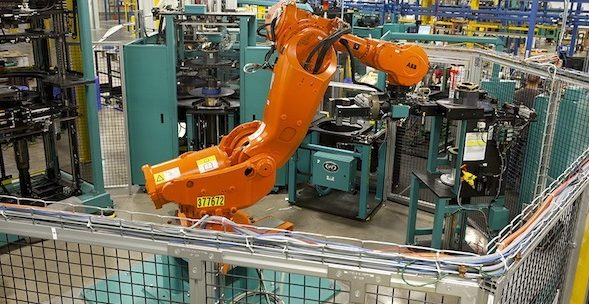Brookings Institution report: The robots are coming, sort of
by January 28, 2019 5:29 pm 713 views

A new report by the progressive Brookings Institution think tank predicts that automation and artificial intelligence (AI) will disrupt virtually all U.S. industries in the coming years, taking note that Arkansas and other “heartland” states will increasingly face the highest exposure of potential job losses and replacements by robots.
The 108-report by the progressive Washington, D.C.-based think tank was released on Jan. 24, nearly two weeks after the U.S. Labor Department’s year-end unemployment report noted that more than 5 million jobs have been added to the U.S. economy in early 2016. Altogether, there are now more than 150 million workers in the nation’s brimming labor force with the U.S. jobless rate at a tidy 3.9%.
In explaining the highlights from the report, the Brookings Institution authors Mark Muro, Robert Maxim and Jacob Whiton explain that their comprehensive study aims to help “clear up” misconceptions on automation. The authors not only used government and private data, but similar past research by the McKinsey Global Institute to develop both backward- and forward-looking analyses of the impacts of robots and AI from 1980 to 2030 across some 800 occupations.
“In doing so, the report assesses past and coming trends as they affect both people and communities and suggests a comprehensive response framework for national and state-local policymakers,” the authors stated.
In the executive summary, the research group concludes that although the road ahead for the U.S. workforce is not a “scary dystopian” prediction that robots will one day take over the world, policymakers and employers still must figure out what the impact will be on their workers and industry.
“Now, the discourse appears to be arriving at a more balanced story that suggests that while the robots are coming they will bring neither an apocalypse nor utopia, but instead both benefits and stress alike,” concluded the Brookings’ authors.
On the positive side, the report states that most observers today agree that the recent past may bode well for the near future as automation in the last 30 years had delivered more jobs to the economy than it destroyed. Automation and AI, it said, are increasingly responsible for productivity gains badly needed to secure the recent higher-quality economic growth in the U.S.
“As such, automation could well lift the national economy in the coming years and increase prosperity at a time of uncertainty,” the report states. On the other hand, Brookings researchers also noted that many workforce experts and economists “in this darker portion of the new conventional wisdom” believe that that rough times are ahead in the labor market that will cause very real dislocations for many workers even if the total number of jobs holds steady.
“All of which underscores how mixed, contested, and uncertain is our knowledge about how automation and similar technologies will hit home in the coming years,” the report predicts.
Closer to home, one of the most comprehensive industry reports to date on the impact of automation and AI highlights that nearly 25% of U.S. employment of the current U.S. labor pool will face high exposure to automation in the coming decades, with greater than 70% of the current workforce at risk of “substitution” or being replaced by a robot or automated equipment.
At the same time, some 36% of the U.S. workforce will experience medium exposure to automation by 2030, while another 39% will experience low exposure. In those occupations at risk in the coming years, the most vulnerable jobs are in office administration, production, transportation and food preparation.
Such jobs are deemed “high risk,” with over 70% of their tasks potentially automatable, even though they represent only one-quarter of all jobs. The remaining, more secure jobs include a broader array of occupations ranging from complex “creative” professional and technical roles with high educational requirements, the report states, to low-paying personal care and domestic service work characterized by “non-routine activities or the need for interpersonal social and emotional intelligence.”
The regions, state and cities that will be most disrupted by automation and AI in the years ahead are the 19 states that the Walton Family Foundation define as so-called “Heartland” states. The states across mid-America have an average employment-weighted automation potential of 47% of current worker tasks, compared with 45% in the rest of the country.
“Much of this exposure reflects Heartland states’ longstanding and continued specialization in manufacturing and agricultural industries,” the report states.
According to Brookings researchers, the average worker in a small metro area with a population of less than 250,000, for example, works in a job where 48% of current tasks are potentially automatable. But that can rise or decline. In small, industrial metros like Kokomo, Ind. and Hickory, N.C. the automatable share of work reaches as high as 55% on average. By contrast, small university towns like Charlottesville, Va. and Ithaca, N.Y., or state capitals like Bismarck, N.D. and Santa Fe, N.M., appear relatively well-insulated.
In the conclusion, Brookings authors offer five policy strategies for states, cities and smaller local communities to adjust to automation. They include embracing technology to power growth, making investments to retool the current labor pool, expanding accelerated learning and certifications, expand support for low-wage jobs, and by “future- proofing” vulnerable regional economies.
To read the Brookings Institution report, click here.
